For years, researchers have puzzled over the origins of Phobos and its twin, Deimos. Some have suggested that the moons are former asteroids attracted by Mars’ gravity, as their chemical composition is similar to that of some rocks in the main asteroid belt between Mars and Jupiter. However, computer models simulating this capture process have failed to reproduce the pair’s nearly circular paths around Mars. Another hypothesis suggests that a giant impact, similar to the one that created our Moon, ejected the duo from the Red Planet; however, Phobos has a different chemical composition than Mars, making this scenario unlikely.
Latest: Mars’ moon Phobos may actually be a comet (or at least part of one) that was captured by the Red Planet’s gravity years ago, according to a new preliminary study based on previously unpublished photographs.
Figuring out exactly how Phobos was born is one of the goals of the Japan Aerospace Exploration Agency’s Mars Exploration Mission (MMX), scheduled to launch in 2026. Sonia Fornasier, a professor of astronomy at Paris-Cité University and lead author of the new study, is an instrument scientist for the MMX mission. While she and other scientists were analyzing images to fine-tune the spacecraft’s planned path, Fornasier stumbled upon unpublished photographs.

A close-up of Phobos. Stickney Crater is the large dent visible in the lower right. NASA/JPL-Caltech/University of Arizona
These 300-plus images, taken by high-resolution cameras on board Mars Express, a European Space Agency (ESA) orbiter that has been studying Mars and its moons since 2003, beautifully document Phobos’s features. They include the 9-kilometer-wide (5.6-mile-wide) Stickney Crater, Phobos’s largest feature.
Fornasier and her colleagues used the images to analyze the intensity of sunlight reflected by Phobos at different angles. This technique, called photometry, allowed them to determine how much light Phobos reflected when the sun was directly in front of it or at an offset angle.
The researchers found that Phobos’s surface did not reflect light uniformly. Some regions, such as the northeastern rim of the crater, were highly reflective. But the team’s analysis also found that Phobos’s surface appeared noticeably brighter overall when the sun was directly overhead. This phenomenon, called an opposition outburst, is common to many airless objects in the solar system. The researchers also found that Phobos’s surface was porous, like sand. This led the team to speculate that the moon’s surface may be obscured by a thick layer of dust with ridged particles whose shadows disappeared when illuminated directly.
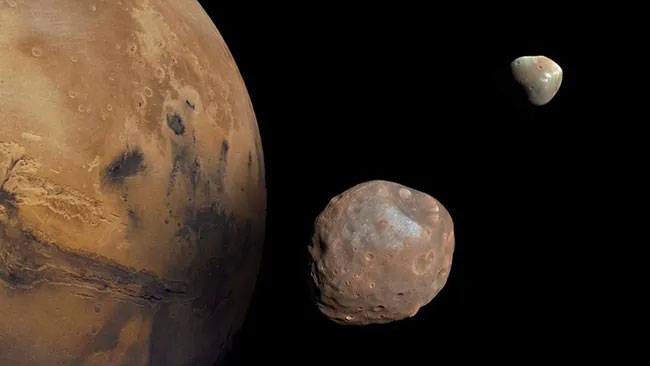
Mars and its two moons, Phobos and Deimos. NASA/JPL/University of Arizona
Both of these properties are also features of Jupiter-family comets, which are comets whose orbits are gravitationally altered by Jupiter. These include the “rubber ducky” comet 67P, which the European Space Agency’s Rosetta mission studied up close in 2016. In fact, Phobos’s photometric properties were a near-perfect match for 67P. The team thus concluded that Phobos may have been a comet captured by Mars.
The study’s findings also have implications for Deimos. Fornasier noted that if Phobos was once a comet, then Deimos could have been one, too. In fact, based on the study, her team suggests that the two moons may have once been combined into a single bipartite comet that was captured and eventually torn apart by Mars’ gravity. In other words, Mars’ twin moons may actually be two halves of a single whole.
“If the Martian moons are indeed captured comets, that means comets can be captured by telluric, terrestrial planets as well,” Fornasier added. She said some moons of gas giants like Saturn likely originated in the Kuiper Belt, the doughnut-shaped region that spans the solar system and from which many comets originate. However, astronomers have yet to identify a “cometary moon” for a terrestrial planet, making Phobos a potential first.
However, interpreting the comet also has its problems. Some photometric parameters, such as the proportion of scattered light, do not match those of comets. In any case, Fornasier said, dynamic modeling that takes into account the motion of celestial objects, including Mars and Phobos, will help the team determine the likelihood of such a comet capture. Ultimately, however, the MMX program, which will physically sample fragments of Phobos, is likely the best hope for resolving the dark origins of this mysterious moon.
2021 version: Mars’ moons Phobos and Deimos may have formed from the remains of a larger moon that once orbited the Red Planet.
While their misshapen shapes and cratered surfaces suggested they were asteroids captured by Mars’ gravitational pull, previous studies had cast doubt on that scenario because of the moons’ nearly circular orbits around the Red Planet’s equator. If the moons were indeed captured asteroids, computer simulations showed they would likely have more irregular orbits, the journal Nature Astronomy reports.
So the researchers also proposed another idea: Phobos and Deimos could have formed from a disk of rock and dust that may have once orbited the infant Mars. However, this scenario faces its own set of problems.
For example, to form two moons of such sizes and distances from Mars, previous studies suggested that a large, massive disk would be needed. With such a disk, the formation of “one larger moon, similar to Earth’s moon, is much more likely,” said lead study author Amirhossein Bagheri, a planetary science researcher at the Swiss Federal Institute of Technology in Zurich.
In addition, previous studies have suggested that the moon-forming disk likely resulted from a cosmic impact, which also created the giant Borealis basin in Mars’s northern lowlands, which covers two-fifths of the Red Planet’s surface. However, Bagheri noted that the impact that formed the basin is thought to have occurred in the earliest stages of the solar system’s formation. If Phobos were that old, based on what researchers know about its orbit, “it should have already fallen onto Mars, and we wouldn’t be able to see it today,” he said.
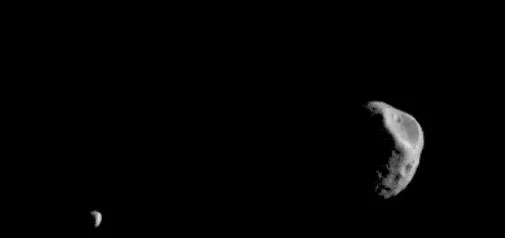
Phobos and Deimos, moons of Mars, were spotted by NASA’s Mars Odyssey orbiter in 2018. A new study suggests the moons are the remains of a larger, broken Martian moon. NASA/JPL-Caltech/ASU/SSI
Bagheri and his colleagues also put forward a new theory: that Phobos and Deimos originated from the remains of a destroyed moon.
Scientists analyzed the latest data on Mars, Phobos, and Deimos, including Martian seismic data from NASA’s InSight lander, to see how the bodies may have evolved over time. They found that the moons’ orbits may have crossed as recently as 1 billion to 2.7 billion years ago, suggesting that they originated from a larger moon that broke apart, likely due to a giant impact.
“I find the idea that Mars once had a larger moon that was hit by one of the many objects flying toward it quite exciting and surprising,” Bagheri said.
Leftover debris from that impact could have rained down on the Red Planet. “The surface of Mars is littered with impact craters, and many of them are estimated to be within the timeframe we calculate for the earlier moon’s destruction event,” Bagheri said.
Scientists noted that while Deimos is moving very slowly away from Mars, Phobos continues to spiral toward the Red Planet. They suggested that it will likely either collide with Mars or be torn apart by its gravitational pull in 39 million years.
Bagheri said future research could learn more about this theoretical moon by taking a closer look at Phobos and Deimos. He noted that new insights could come from the Japanese space agency’s upcoming Mars Moon Survey Mission, which aims to collect samples from Phobos.
The 2018 version: Phobos and Deimos were formed by a giant impact with Mars itself, which makes a lot of sense given their orbital paths. But that explanation doesn’t quite fit: Both of these tiny moons appear incredibly dark, like a certain class of carbon-rich asteroids, suggesting they were born in the asteroid belt, flew too close to Mars, and got trapped by the planet’s gravity. Phobos is about 14 miles (22 km) wide, while Deimos is 8 miles (13 km) wide.
“It was fun for me to test some of the existing ideas using an old data set that had been underused,” said lead author Tim Glotch, a geologist at Stony Brook University in New York, in a statement released by the American Geophysical Union, which publishes the journal that published the new study, the Journal of Geophysical Research: Planets.
The old data set was collected in 1998 by NASA’s Mars Global Surveyor, which measured the heat signature of Phobos, the larger of the two Martian moons. Glotch and his colleagues compared that data with data from a range of Earth rocks and a tiny piece of meteorite collected near Tagish Lake in western Canada. The scientists believe that meteorite broke off from the same type of asteroid that is thought to have formed the moons.
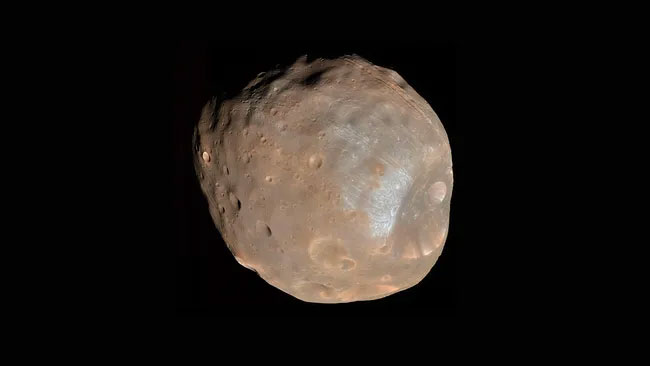
Phobos is the larger of Mars’s two small moons, and it shows signs of millennia of small impacts. NASA/JPL-Caltech/University of Arizona
But it turns out the old Phobos data didn’t match the Tagish meteorite very well. “In fact, what’s most consistent with Phobos, or at least one of the features in the spectrum, is crushed basalt, which is a common volcanic rock and what makes up most of the Martian crust,” Glotch said in a statement.
“This makes us think that perhaps Phobos could be the remnant of an impact that occurred early in Martian history,” he said. This old Martian material could have been mixed in with other impact material.
If the research team is right, this insight would fix a perceived flaw in the giant-impact theory of the formation of the Martian moon. And, conveniently, scientists might not have to dig up more than a decade’s worth of data to answer the question.
Europe’s Mars Express spacecraft peered deeper into the Martian moon Phobos in 2022 than ever before, discovering traces of unknown structures that could hold clues to the moon’s origins.
Mars Express, a spacecraft that had been orbiting Mars for 19 years at the time, approached Phobos to within 51.6 miles (83 kilometers) of the moon on September 22, 2022, and was able to probe beneath the moon’s surface using updated software on its Mars Advanced Radar for Subsurface and Ionosphere Sounding (MARSIS) instrument.
Understanding Phobos’s internal structure could be key to solving the mystery of its origin. “We are still at an early stage of our analysis, but we have already seen possible signs of previously unknown features beneath the moon’s surface,” said Andrea Cicchetti, a member of the MARSIS science team at INAF, the Italian National Institute for Astrophysics, in a statement.
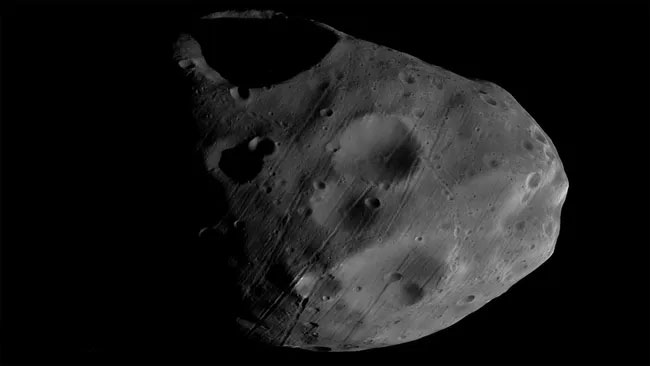
A close-up of the Martian moon Phobos. ESA/DLR/FU Berlin
Mars has two moons, named Phobos and Deimos after the gods of “fear” and “panic” in Greek mythology. Unlike the main moons of our solar system, Phobos and Deimos are tiny, measuring just 16.7 miles (27 kilometers) and 9.3 miles (15 kilometers) across, respectively. They have a similar composition to carbonaceous C-type asteroids, and are also irregularly shaped like asteroids, leading to suspicions that they are actually rogue asteroids captured by Mars’ gravity. However, Phobos and Deimos’ orbits around the red planet pass over Mars’ equator, and both orbits are extremely circular, suggesting that they formed around Mars. If they were captured, they would be expected to have more elliptical orbits in different planes.
“Whether Mars’ two small moons are captured asteroids or composed of material torn off Mars during a collision remains an open question,” Colin Wilson, a scientist on the European Space Agency’s Mars Express mission, said in the same statement.
MARSIS includes a 40-meter antenna that beams low-frequency radio waves down toward the surface. Most of the radio waves are reflected directly from the surface, but some penetrate deeper, where they encounter transitions between layers of different composition and structure and are reflected back by these boundaries. The stronger the reflection in the resulting “radargram,” the brighter the returning radio signal.
A radargram from a narrow track on Phobos shows a bright line split into two, labeled A–C and D–F respectively. Section A–C was captured using the older MARSIS software for comparison with D–F, which uses newer software and shows much more detail. The main bright line is a reflection from Phobos’s surface, but there is evidence of fainter lines beneath it that may simply be interference or “clutter” from features on the surface, but they could also be caused by structures beneath the surface.
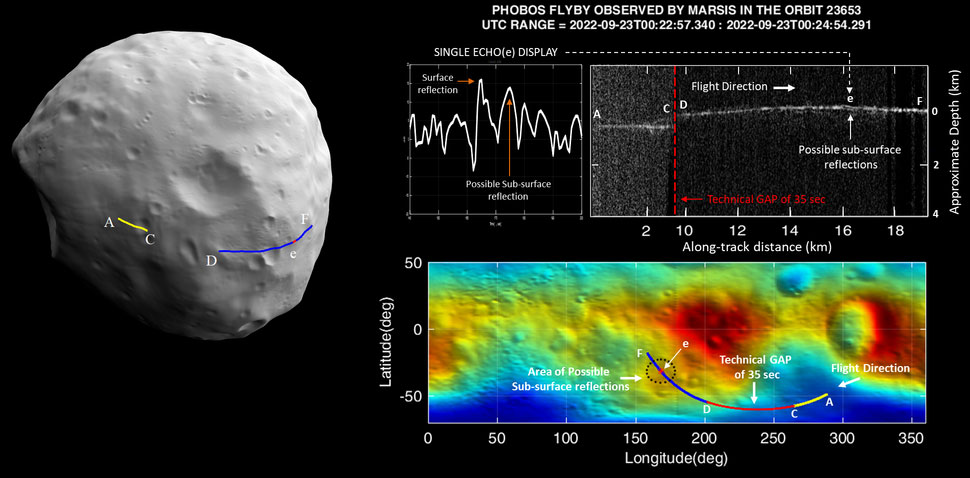
A “radargram” taken by MARSIS during its flyby of Phobos on September 23, 2022. The radargram shows the “echoes” that occur when the radio signal emitted by MARSIS bounces off something and returns to the instrument. INAF – National Institute of Astrophysics
MARSIS was designed to explore the interior of Mars from an orbital distance of more than 155 miles (250 kilometers), but a software upgrade has allowed MARSIS to operate at much closer distances and be used during close flybys of the moons.
Getting even closer to Phobos will allow radargrams to be obtained with even greater resolution than those achieved here. The plan over the next few years is to operate MARSIS at distances of up to 40 kilometers (24.9 miles) from Phobos.
“Mars Express’ orbit has been fine-tuned to allow us to get as close to Phobos as possible over multiple flybys between 2023 and 2025,” Cicchetti said.
Mars Express isn’t the only mission headed to Phobos. The Japan Aerospace Exploration Agency (JAXA) plans to launch the Martian Moon eXploration (MMX) spacecraft in September 2024. Similar to JAXA’s Hayabusa2 mission to retrieve samples from the near-Earth asteroid Ryugu, MMX will collect at least 10 grams of regolith from the surface of Phobos. MMX will also send a small rover to the surface before exploring Mars’ second moon, Deimos, and then returning to Earth with precious Phobos samples to be analyzed in scientific labs on Earth.




